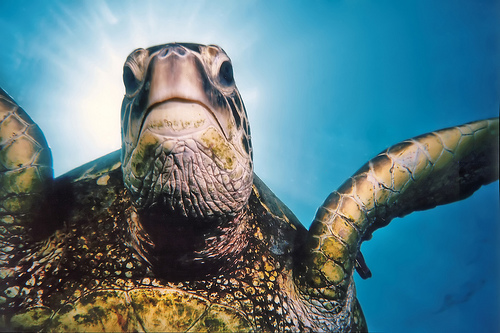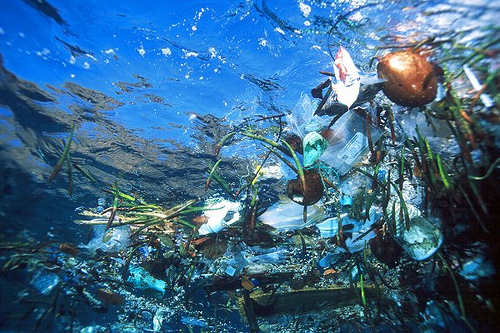
By Celia Ste Croix

The following article does not make claims of expertise on the subject matter.
The world's oceans are full of garbage.
There is no plan to clean it up and the problem is growing.
In 1997, scientific researcher Captain Charles Moore was the first to report witnessing huge collections of floating garbage in the Pacific Ocean. GyreCleanUp.org estimates that 11 million tons of plastic pollution is floating above and below the surface just in the North Pacific Gyre alone.Eighty percent is of this garbage is land-based refuse and the remaining 20% is discarded directly into the sea or at the coast by pleasure cruisers, the military and maritime industries. Less than 5% of all plastics in the world are recycled. The rest go into landfills, clutter the landscape and pollute the gyres where they break down where marine life ingests them.
In 2006, the United Nations Environmental Program (UNEP) reported that there were approximately 46,000 pieces of floating marine debris in every square mile of ocean. It is extremely difficult, however, to measure the exact amount of garbage floating in the world's oceans because the area is so vast and the debris moves, making it impossible to accurately map. The North Pacific Garbage Patch was estimated in 2007 to cover an area slightly smaller than the province of Quebec. It is assumed to be larger now.

The way that currents and wind move across the earth's oceans creates a kind of vortex effect. This vortex is called a gyre and it draws floating debris into huge areas at the ocean's centers. There are five gyres in the world and it is believed that there is a garbage patch in each one.
So what if there's garbage in the ocean?
For marine life this debris is an ever-present disaster. Birds can easily swallow bottle caps and large plastics that stay in their stomachs, eventually starving them. Sea turtles mistake clear flexible plastic for jellyfish, their main food source, and often choke on the debris. Marine mammals, like seals and dolphins, can be strangled or immobilized by plastic netting and other materials wrapping around their mouths, necks and extremities. There are countless other heart breaking examples.
For humans, the implications are less visible. Plastic products break
down, through sunlight and saltwater, releasing various toxic chemicals
such as PCBs, PVCs, dioxins and phthalates. Because the chemical
elements of plastics are not water soluble, the broken down particles
get ingested by marine life as solids. Many of the chemicals present in
the gyres, like mercury and pesticides are known carcinogens and many
others are suspected carcinogens. Small fish ingest the plastic
particles and, if they are not killed by the debris, these small fish
are in turn eaten by larger prey until eventually those tiny particles
and chemical elements end up in our food supply, either indirectly as
feed for livestock and as an ingredient in farm fertilizers or directly
as our high price salmon fillet. For many countries with large coastal
regions, fishing is a main source of food.
There is also the implication that, if left unresolved, this problem
could grow, killing off all marine life and leaving the planet with a
massive ecological crisis.

What is being done?
Because the oceans are international space and the waste comes from
all over the world there is no one government or ruling body that can be
held accountable or lay blame. The United Nations Environmental Program
(UNEP), affiliated with the United Nations, is attempting to address
the issue. For example, at the Stockholm Convention in 2001 twenty-one
Persistent Organic Pollutants (a term for plastics and other waste
materials that break down slowly or not at all) were put on the
"strictly controlled" list. The UNEP maintains that there must be a
collective effort at all levels of government, as well as socially and
commercially, to solve the problem and prevent further damage.
In the United States, some cities string nets across rivers to collect
debris that washes into the water system during heavy rainfall. They
then remove this debris to land-fills.
Most of the burden of action, however, seems to fall to the
Non-government Organizations (NGOs) and non-profit organizations. The
Five Gyres Institute is one of many organizations promoting awareness
and conducting research of the garbage patches and their impact.
Algalita Marine Research Foundation, founded by Charles Moore, holds
Algalita's International Youth Summit through which it attempts to
engage students and educators around the world in "action-oriented,
solutions-based education about plastic marine pollution."
Even with all the conferences, resolutions, research and awareness
campaigns the solution is not a clear-cut one. There have been and still
are many people working on solutions for cleaning up the garbage
patches but no viable, lasting solution has been found.
To date, the following proposals have been made:
Manual removal
Why don't we just take a big net out there and scoop up the mess? The problem with this straightforward solution is three fold. One: only a small percentage of the physical debris floats on the surface, the rest is submerged and can be as far down as the ocean floor. Two: contrary to what one might imagine, the garbage patches are not unified masses of floating debris that collect and stay together. The plastics only collect when physically attached together as in a discarded fishing net, an inlet or bay, a bird's stomach or a sticky substance like crude oil. This means you would have to troll vast areas to collect the loose debris. Also, as time passes, more and more of the plastic materials break down and some plastics start out tiny, such as minute beads in cosmetic skin cleansers. This debris is so small that you would need a screen-like material to collect it. This brings us to problem number three: when scooping waste out of the ocean you are also scooping out mass amounts of zooplankton, invertebrates and tiny fish that are the basis of the food chain of all marine life. The negative impact on the ecosystem would be enormous.
Plastics ban
Many environmentalists say that reducing the use of plastics and finding alternative packaging modes will stem the growing problem in the gyres. However, more than a decade after the garbage patches' discovery even if the whole world were to suddenly stop producing any form of plastic or rubber-based items there would still be an estimated 74 000 plastic items per square kilometre swirling in the oceans with nowhere to go but straight into the food chain. It is also unfeasible for humans to stop using plastic, latex and rubber products at this time. If you consider scientific and medical uses alone, we are dependent on these products for many, many applications until we come up with alternative options.
Recycling
As with the idea of banning plastics, recycling is a long-term plan and a viable solution for stemming the growth of the garbage patches. However recycling alone will not take the plastics out of the oceans.
Converting plastics into fuel
Project Kaisei proposes creating an economically driven solution by finding a way to make the gyre plastics into a fuel or transform the material into some kind of derivative product. This model suggests that if investors or companies wanted to collect the plastic material they could then turn it into profit. No technology exists yet to transform the plastic materials in this way and no financial body or person seems interested in developing it.
Plastic consuming microbes
Scientific research has developed microbiological technology for oil spill clean-up and this could potentially be applied to the problem in the gyres. Scientists at University College Dublin have been working on a kind of microbe that will actually consume plastic materials without disrupting the surrounding ecosystem. This technology is still mostly theoretical but it is not science fiction so it could become part of the solution.
What can I do?
You could buy a boat and dedicate your life to sifting the trash out
of the world's oceans. But if that is not the best solution for you
there is still a lot you can do to prevent the patches from growing.
Recycle
Each time you throw something away you are making a choice about the environment. Currently, only 5% of the world's plastics are recycled, but it is in your power to raise that percentage.
Buy wisely
Many consumer goods, like cosmetics and household products, contain toxic chemicals and tiny plastics that wash down the drain and out to sea. Consider what is in what you buy and where it goes when you dispose of it. Two alternatives to plastic products are biodegradable and hemp plastics. Many green and environmentally-friendly products exist that can replace those with toxic ingredients. Inform yourself about low impact products and use your wallet to change corporate policies in favour of eco-friendly ingredients and products.
Get political
Pressure your government to change civic and state policies in order to put in place mandates to prevent more ocean pollution and to do our nation's part in cleaning up what is already there.
Organizations:
- www.gyrecleanup.org/
- www.thecleanoceansproject.org/
- www.5gyres.org/
- www.algalita.org/index.php
- www.projectkaisei.org/
- Reports and articles:
- www.unep.org/yearbook/2011/pdfs/plastic_debris_in_the_ocean.pdf
- unep.org/pdf/op_april/EN/OP-2011-04-EN-ARTICLE7.pdf
- inhabitat.com/great-pacific-garbage-patch-is-worse-than-we-thought/
- safepla.net/crisis.html
- blogfishx.blogspot.com/2008/05/ocean-garbage-mess-and-possible.html
- theoystersgarter.com/2008/05/14/so-weve-got-this-trash-filled-gyre-right-can-we-fix-it/
- www.hemphasis.net/Building/plasticmettle.htm
- www.degradable.net/what-is-d2w/what-is-d2w/
- www.inspirationail.com/non-toxic-nail-polish/
- www.amazon.ca/Ecoholic-Environmentally-Friendly-Information-Products/dp/0679314849

Leave a comment